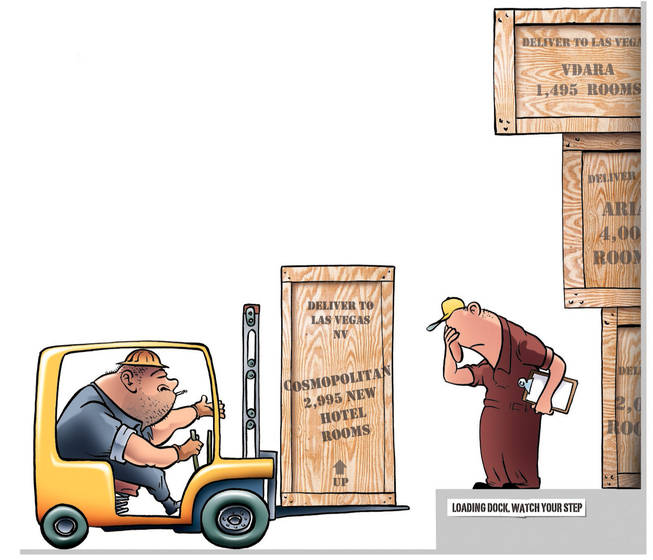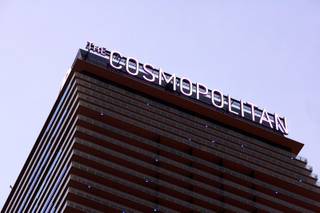Sunday, Dec. 12, 2010 | 2 a.m.
Sun coverage
By the Numbers
- Opening: Dec. 15, 2010
- Groundbreaking: Oct. 25, 2005
- Initial cost estimate: $1.8 billion (Oct. 2005)
- Final Cost: $3.9 billion
- Land: 8.7 acres between CityCenter and Bellagio
- Strip frontage: 335 feet
- Permanent jobs: About 5,000
- Rooms: 2,995
- Rooms with terraces: About 2,200
- Casino size: 100,000 square feet
- Restaurants: 12
- Bars and lounges: Four
- Nightclubs: One
- Retail space: 36,000 square feet
- Convention space: 150,000 square feet
- Spa: 43,000 square feet
- Pools: Three
Sun archives
- Staff putting finishing touches on Cosmopolitan (12-3-2010)
- New Year’s at Cosmopolitan: 1 room, 3 nights, $5,600 (12-2-2010)
- Cosmopolitan launches six-part video series ahead of Las Vegas Strip opening (11-30-2010)
- Killers frontman Brandon Flowers to highlight Cosmopolitan’s opening night show (11-8-2010)
- Cosmopolitan chief reveals more details about new resort (10-28-2010)
- Cosmopolitan’s jarring ad aimed at the ‘curious class’ (10-22-2010)
- Cosmopolitan announces lineup of stores, boutiques (10-20-2010)
- Cosmopolitan CEO plans to steal customers from Strip competitors (8-22-2010)
- Cosmopolitan resort-casino unveils Strip marquee (8-3-2010)
The Cosmopolitan of Las Vegas opens this week with the trappings of every other luxury megaresort built in Southern Nevada over the past two decades — a convention center, nightclub, spa, pools, restaurants and shopping.
But you wouldn’t know it from its surreal TV commercial.
The 60-second ad features, in no particular order, women sitting on men’s hunched backs and sipping cocktails,
a woman using her spiked heel to lace up another’s corset, a bellhop wearing no pants, an elderly woman patting a young man’s behind and litters of puppies, kittens and baby chicks roaming through the hotel, drawing glances from silky-haired models in black dresses and dark lipstick.
Not exactly the usual Vegas spiel.
And for a reason. The Cosmopolitan — purchased at a foreclosure sale by a bank that has sunk $3.9 billion into it — needs to distinguish itself in a recession-scarred town with more hotel rooms than it can fill.
And the carefully scripted marketing campaign seems to be working. Jim Long — a marketing specialist who has traveled the world — saw the commercial in his Manhattan office and says he loved the imagery.
He says he is a fan of the “offbeat and unexpected,” and says this place might fill the bill.
Bull’s-eye. Long is just the sort of customer whom Cosmopolitan CEO John Unwin describes as a member of the “curious class” — people who are “creative, independent, broad-minded and love foreign food and travel” and not driven to choose hotels on such mundane characteristics as customer reviews, room rates and loyalty “points.”
Whether the 2,995-room Cosmopolitan succeeds or fails may depend on how many Jim Longs see the ad and decide to check it out.
Unwin thinks he has a fighting chance, as there are millions of these curious travelers in the United States, including many who already come here.
No major resort in Las Vegas effectively targets these travelers, Unwin said. Other luxury resorts fall short because they lack authenticity or take themselves too seriously, he said.
This may sound like so much psychobabble. But the Cosmopolitan and its marketing campaign are the culmination of months of research, including surveys and focus group interviews, to pinpoint the most effective target audience, Unwin said.
And for good reason.
Over the next year, the Cosmopolitan must overcome a daunting math problem: How to book more than 1 million room nights in a recession.
It’s difficult for a hotel to be truly distinctive because many attributes such as design and service are dictated by the property’s size, said Bjorn Hanson, dean and professor of the Preston Robert Tisch Center for Hospitality, Tourism and Sports Management at New York University. Every 1,000 rooms require nearly 300,000 guests per year to be profitable, so large hotels “are generally not able to appeal to narrow niche markets,” he said.
However, some industry observers are applauding the television ad, saying it could create buzz for the resort.
“I don’t quite get it, but I love it,” said Mehmet Erdem, a hotel management professor at UNLV. “And people are talking about it.”
“I’m pretty impressed,” added Billy Vassiliadis, CEO of advertising and public relations firm R&R Partners, the Las Vegas firm that created the “What happens here, stays here” campaign. “It’s unusual, arty and surreal, which probably (works for the) urban sophisticate and discerning party person.”
It’s a departure from typical travel imagery such as canoodling couples and women in bikinis, although Las Vegas and its hotels have also used plenty of provocative imagery to sell resort tourism. The Cosmopolitan’s cheeky tagline, “Just the right amount of wrong,” seems but a slight twist on the “What happens here” slogan.
The imagery tested well with the Cosmopolitan’s target audience — people who shun tourist traps, chain hotels and mass-market brands in favor of the eclectic and unexpected, Unwin said.
“The definition of luxury has changed in the last few years. People now are less interested in status ... and more interested in experiences.”
With his staff, Unwin uses a photo of an elegant Louis Vuitton suitcase to represent the “old” standard of luxury. The Cosmopolitan’s aesthetic is better represented in another photo of a battered leather duffel bag, he said, “because it’s all about the places I’ve been and what I’ve experienced and who I’ve done it with.”
Travelers can go to places such as San Francisco and New York to cultivate their inner bohemian without bothering with Las Vegas and its cheesy factor, which still appeals to many visitors, critics say. Are there enough urban sophisticates to make Cosmopolitan work?
Unwin, a veteran of Caesars Palace and major hotel chains, thinks so.
“We sized the market opportunity, and it makes sense,” he said. “Customers want something interesting and different.”
Cosmopolitan is reaching out to this audience in different ways. While Las Vegas hotels flood Twitter accounts with package deals, discounts and event announcements, Cosmopolitan’s Twitter feed includes frequent links to discussions about art and culture that have little to do with Las Vegas — but might interest the culturally aware customers the property seeks.
A more obvious marketing pitch, two-minute videos of interviews with designers who worked on the Cosmopolitan, began airing recently on the Independent Film Channel and Sundance Channel. In one, interior designer David Rockwell discusses his design choices for hotel rooms down to the pop art-inspired wallpaper in the closets.
The Cosmopolitan’s ad sends customers to its website, where the hotel books rooms directly with customers.
The television ad has worked so far, said Lisa Marchese, Cosmopolitan senior vice president of brand marketing.
“The overall feedback has been, ‘That’s interesting, I want to see more,’ ” she said. “The point is that we’re creating a sense of discovery — and that you’re going to discover something that is going to be (meaningful) for you. We’re not trying to be all things to all people.”
Las Vegas resorts have embraced high-concept image advertising since the 1989 opening of Steve Wynn’s Mirage, an elaborate resort that transformed the city into more than a gambling town.
TV ads for the Mirage flashed glimpses of its exterior while showing stylish travelers in major cities rushing into cabs, trains and planes to pay a visit. The spots and the tagline, “There’s a new destination in the world,” were intended for a broader audience, including international visitors, than had ever been attempted for a Las Vegas hotel, said John Schadler, managing partner of Las Vegas advertising agency SK+G, who oversaw the campaign.
A TV spot launching Wynn’s Bellagio in 1998 used the music of Andrea Bocelli, an attractive couple and the Italiante architecture to create a modern-day Romeo and Juliet scene. Like the Mirage’s spot, the ad, ending with the catchphrase “And so it begins,” attempted to communicate that a new bar for luxury had been set, Schadler said.
Recent ads for CityCenter’s Aria are a modern twist, showing embracing couples in locations that reveal its modern architecture. “The center of pleasure has shifted,” says one, referring to its center Strip location and one-stop collection of attractions.
As resorts opened with increasingly diverse amenities, marketing campaigns grew more sophisticated, Schadler said.
“I think there’s still a core Las Vegas audience,” he said. “But the market has grown because of the extent to which the brands offer more options to customers.”
Although the images in the Cosmopolitan ad are different, its provocative message isn’t unique, Schadler said. Nor, he said, is the concept that hotel guests seek meaningful experiences when they stay at a luxury property rather than simply the prestige of a particular brand name.
There is, of course, another school of thought on how tourists pick their hotel. Given the increasing ease of online comparison shopping, it’s price, rather than clever marketing, that has become the deciding factor for many guests choosing among luxury hotels, said Bill Eadington, director of the Institute for the Study of Gambling and Commercial Gaming at UNR.
Long, the Manhattan businessman, agrees that many travelers still seek the conventional and expected — and the comfort of known luxury brands.
And Las Vegas needs places that cater to travelers with a taste for society’s fringes. Otherwise, the Strip risks becoming a “been there, done that” destination, Long said.
But then he cautions that with its TV ad, Cosmopolitan may have gone too far in trying to appeal to travelers like himself:
“You don’t want to be too inaccessible and too fabulous,” he said. “Maybe it’s too Stanley Kubrick.”



Join the Discussion:
Check this out for a full explanation of our conversion to the LiveFyre commenting system and instructions on how to sign up for an account.
Full comments policy